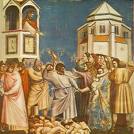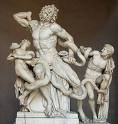
| Next | Previous | Index | Tellout Home |
60. Great Prostitute
Revelation 17.1-5
"One of the seven angels with the seven bowls came and said to me, 'Come, I will show you the great prostitute's punishment, sitting by many water bodies. With her, the earth's kings committed adultery, and the earth's inhabitants became intoxicated with her adulterous wine.' Then the angel carried me away in the Spirit into a wilderness. There I saw a woman sitting on a scarlet beast covered with blasphemous names with seven heads and ten horns. The woman was dressed in purple and scarlet and was glittering with gold, precious stones, and pearls. She held a golden cup in her hand, filled with abominable things and the adulterous filth. The name written on her forehead was a mystery. 'BABYLON THE GREAT THE MOTHER OF PROSTITUTES AND THE ABOMINATIONS OF THE EARTH.'" (Revelation 17.1-5) ✞
Great Prostitute
 The "great prostitute" is called by John of Patmos, "Babylon the Great, the Mother of Prostitutes and Abominations of the Earth." These names disguise a direct reference to the immorality of the Roman Empire. Many Jewish persons and Christians would have known what John meant. The Roman government is punished as "the great prostitute" because she is "a temptation to godlessness and wickedness." Her sin is that she sins herself and that she deliberately persuades others into sin. "The great prostitute" deserves punishment because of her many gods and that she shed the Christian martyrs' blood. She produces a seductive governmental system that uses immoral means to gain pleasure and prosperity. ✞
The "great prostitute" is called by John of Patmos, "Babylon the Great, the Mother of Prostitutes and Abominations of the Earth." These names disguise a direct reference to the immorality of the Roman Empire. Many Jewish persons and Christians would have known what John meant. The Roman government is punished as "the great prostitute" because she is "a temptation to godlessness and wickedness." Her sin is that she sins herself and that she deliberately persuades others into sin. "The great prostitute" deserves punishment because of her many gods and that she shed the Christian martyrs' blood. She produces a seductive governmental system that uses immoral means to gain pleasure and prosperity. ✞
Rome's Extravagant Luxury
 The great prostitute is said in Revelation 18.11-12a to be clothed in purple silk cloth and decked with numerous ornaments. Rome's extravagant luxury refers to the rare, expensive, beautiful red and purple clothing, the gold and silver decorations, and the lustful way the prostitutes use them. It is a picture of a wealthy female prostitute, decked out in her expensive finery, determined to seduce men. ✞
The great prostitute is said in Revelation 18.11-12a to be clothed in purple silk cloth and decked with numerous ornaments. Rome's extravagant luxury refers to the rare, expensive, beautiful red and purple clothing, the gold and silver decorations, and the lustful way the prostitutes use them. It is a picture of a wealthy female prostitute, decked out in her expensive finery, determined to seduce men. ✞
Babylon's Golden Cup
 The Babylonian woman covered with blasphemous names is sitting on a beast with seven heads and ten horns. She holds a golden cup full of abominations. This description is similar to another picture of Jeremiah's golden cup. Jeremiah 51.7 explains, "Babylon was a gold cup in the Lord's hand. She made the whole earth drunk. The nations drank her wine; therefore, they have now gone mad." Rome is Babylon's hidden identity and is said to hold this cup full of abominations, which she spreads over all the earth, meaning the Roman Empire. ✞
The Babylonian woman covered with blasphemous names is sitting on a beast with seven heads and ten horns. She holds a golden cup full of abominations. This description is similar to another picture of Jeremiah's golden cup. Jeremiah 51.7 explains, "Babylon was a gold cup in the Lord's hand. She made the whole earth drunk. The nations drank her wine; therefore, they have now gone mad." Rome is Babylon's hidden identity and is said to hold this cup full of abominations, which she spreads over all the earth, meaning the Roman Empire. ✞
Forehead Name
 Babylon's great prostitute is said, according to Revelation 17.5, to have "the name written on her forehead." In Rome, prostitutes in the public brothels wore plate frontlets or ornaments upon their foreheads, giving their names. This vivid detail pictures Rome as a tremendous corrupting influence and the scarlet Babylon woman among the corrupted nations. ✞
Babylon's great prostitute is said, according to Revelation 17.5, to have "the name written on her forehead." In Rome, prostitutes in the public brothels wore plate frontlets or ornaments upon their foreheads, giving their names. This vivid detail pictures Rome as a tremendous corrupting influence and the scarlet Babylon woman among the corrupted nations. ✞
The Prostitute
 The great prostitute holds a golden cup filled with terrible things. She is said in Revelation 17.1 "to sit upon many water bodies." Bodies of water may indicate either oceans, seas, worldwide commerce, or a well-provisioned large city. It is possibly a reference to the seven hills of Rome. John of Patmos incorporates many of the prophet's ideas about ancient Babylon. Jeremiah 51.13 addresses them as, "You who live by many bodies of water and are rich in treasures, your end has come, your destruction time." The River Euphrates is one of Western Asia's longest and most historically significant rivers. It runs through the ancient city of Babylon in present-day Iraq. It is also the center of an irrigation canal system through Turkey, Syria, and Iraq to the Persian Gulf, with lakes spreading in every direction. Rome is often addressed as "Babylon," maybe to conceal her true identity from readers, and is also a picture of Rome's significant corrupting influence on many nations. ✞
The great prostitute holds a golden cup filled with terrible things. She is said in Revelation 17.1 "to sit upon many water bodies." Bodies of water may indicate either oceans, seas, worldwide commerce, or a well-provisioned large city. It is possibly a reference to the seven hills of Rome. John of Patmos incorporates many of the prophet's ideas about ancient Babylon. Jeremiah 51.13 addresses them as, "You who live by many bodies of water and are rich in treasures, your end has come, your destruction time." The River Euphrates is one of Western Asia's longest and most historically significant rivers. It runs through the ancient city of Babylon in present-day Iraq. It is also the center of an irrigation canal system through Turkey, Syria, and Iraq to the Persian Gulf, with lakes spreading in every direction. Rome is often addressed as "Babylon," maybe to conceal her true identity from readers, and is also a picture of Rome's significant corrupting influence on many nations. ✞
Martyr's Blood
 John of Patmos in Revelation 17.15 gives the waters a symbolic interpretation. He writes, "The waters you saw, where the great prostitute sits, are peoples, multitudes, nations, and languages." The waters are the many nations Rome rules and influences for evil. In contrast to the prostitute, the Bride of Christ, the church, is pure and obedient. The prostitute bears all the abominations that the Lord hates. Proverbs 6.16-19 lists them, "six things the Lord hates, seven that are detestable to him: ✞
John of Patmos in Revelation 17.15 gives the waters a symbolic interpretation. He writes, "The waters you saw, where the great prostitute sits, are peoples, multitudes, nations, and languages." The waters are the many nations Rome rules and influences for evil. In contrast to the prostitute, the Bride of Christ, the church, is pure and obedient. The prostitute bears all the abominations that the Lord hates. Proverbs 6.16-19 lists them, "six things the Lord hates, seven that are detestable to him: ✞
The Lord Hates
1. Haughty eyes,
2. A lying tongue,
3. Hands that shed innocent blood,
4. A heart that devises wicked schemes,
5. Feet that are quick to rush into evil,
6. A false witness who pours out lies,
7. A person who stirs up community conflict."
The Church's Seed
 These abominations are still seen in society today! Throughout history, people have died at the hands of oppressive governments for their faith. The great prostitute's drunkenness shows her pleasure in evil accomplishments and her triumphal persecution of Christians. But every martyr who dies for their faith only serves to strengthen the church's resolve. As the Church Father Tertullian (c155-c240 AD), a prominent North Africa theologian, noted in "Apologeticus Chapter 50," "the martyrs' blood is the Church's seed." The church's seed takes root and grows beyond all expectations! ✞
These abominations are still seen in society today! Throughout history, people have died at the hands of oppressive governments for their faith. The great prostitute's drunkenness shows her pleasure in evil accomplishments and her triumphal persecution of Christians. But every martyr who dies for their faith only serves to strengthen the church's resolve. As the Church Father Tertullian (c155-c240 AD), a prominent North Africa theologian, noted in "Apologeticus Chapter 50," "the martyrs' blood is the Church's seed." The church's seed takes root and grows beyond all expectations! ✞
Scarlet Beast Names
 The scarlet beast names are the blasphemous titles of this seven-headed beast with ten horns referring in a veiled manner to ten Roman Emperors and Rome's imperial city. Like the earlier beast, a scarlet beast comes from the sea in Revelation 11.7 and appears as the great prostitute's accomplice. Blasphemous names cover the woman sitting on the creature. If the woman is Rome, the beast is the Roman Empire, full of blasphemy, referencing its many gods. Every scarlet beast's name insults Almighty God, for they are infringements on God's supreme and unique authority. No one has the right to call himself God, save only the one true deity. The beast's blasphemous names may also be a reference to the many titles emperors claimed. One emperor was called "Augustus," which meant "reverenced." Another emperor was named "theios," which in Greek means "divine." Some emperors called themselves "soter" or "savior." Most common of all, an emperor often named himself in Latin "dominus" or Greek "kurios," meaning "Lord," which is God's very own name. ✞
The scarlet beast names are the blasphemous titles of this seven-headed beast with ten horns referring in a veiled manner to ten Roman Emperors and Rome's imperial city. Like the earlier beast, a scarlet beast comes from the sea in Revelation 11.7 and appears as the great prostitute's accomplice. Blasphemous names cover the woman sitting on the creature. If the woman is Rome, the beast is the Roman Empire, full of blasphemy, referencing its many gods. Every scarlet beast's name insults Almighty God, for they are infringements on God's supreme and unique authority. No one has the right to call himself God, save only the one true deity. The beast's blasphemous names may also be a reference to the many titles emperors claimed. One emperor was called "Augustus," which meant "reverenced." Another emperor was named "theios," which in Greek means "divine." Some emperors called themselves "soter" or "savior." Most common of all, an emperor often named himself in Latin "dominus" or Greek "kurios," meaning "Lord," which is God's very own name. ✞
Seven-Headed Beast
 A woman sits on a seven-headed beast identified with the seven ancient Roman hills. The monster in Revelation 17 has "seven heads and ten horns," the same description as the Roman Empire Beast in Revelation 13.1-2 of a creature coming from the sea. It has ten crowns on its horns and a blasphemous name on each head. The beast resembles a leopard with a bear's feet and a lion's mouth, and one of the beast's heads has a healed fatal wound. The whole world is wonderstruck and follows the creature. People worship the dragon because of its authority, and they worship the beast and ask, 'Who is like the beast?' ✞
A woman sits on a seven-headed beast identified with the seven ancient Roman hills. The monster in Revelation 17 has "seven heads and ten horns," the same description as the Roman Empire Beast in Revelation 13.1-2 of a creature coming from the sea. It has ten crowns on its horns and a blasphemous name on each head. The beast resembles a leopard with a bear's feet and a lion's mouth, and one of the beast's heads has a healed fatal wound. The whole world is wonderstruck and follows the creature. People worship the dragon because of its authority, and they worship the beast and ask, 'Who is like the beast?' ✞
Forty-Two Months
 "The beast's mouth utters proud blasphemous words and exercises its authority for forty-two months," says Revelation 13.6-8. This number indicates that its authority is temporary. Then the Beast "opened its mouth to blaspheme God, slander his name, dwelling place and those living in heaven. It has the power to wage war against God's holy people and to conquer them. And it had authority over every tribe, people, language, and nation. All of earth's inhabitants will worship the beast, those not written in the Lamb's book of life, the slain Lamb from the world's creation." Revelation 17.8 tells us also, "The beast, which you saw, once was, now is not, and yet will come up from the Abyss and to its destruction." The beast's past, present, and future hints at the "Nero Redivivus legend," or Nero's resurrection, which is never far from John of Patmos' mind. In Revelation 17.11, we read, "The beast who once was, and now is not, is the eighth king. This title is a strange imitation of God's Trinitarian name as "I am, I was, and I will be." He belongs to the seven and is going to his destruction." The idea of a resurrected Nero connects with the Antichrist theme. In this passage, the scarlet beast stands for the Antichrist. According to Revelation 17.9, the "seven heads are seven hills on which the woman sits." Ancient Rome's seven hills indicate and identify it here as the seven-headed beast. ✞
"The beast's mouth utters proud blasphemous words and exercises its authority for forty-two months," says Revelation 13.6-8. This number indicates that its authority is temporary. Then the Beast "opened its mouth to blaspheme God, slander his name, dwelling place and those living in heaven. It has the power to wage war against God's holy people and to conquer them. And it had authority over every tribe, people, language, and nation. All of earth's inhabitants will worship the beast, those not written in the Lamb's book of life, the slain Lamb from the world's creation." Revelation 17.8 tells us also, "The beast, which you saw, once was, now is not, and yet will come up from the Abyss and to its destruction." The beast's past, present, and future hints at the "Nero Redivivus legend," or Nero's resurrection, which is never far from John of Patmos' mind. In Revelation 17.11, we read, "The beast who once was, and now is not, is the eighth king. This title is a strange imitation of God's Trinitarian name as "I am, I was, and I will be." He belongs to the seven and is going to his destruction." The idea of a resurrected Nero connects with the Antichrist theme. In this passage, the scarlet beast stands for the Antichrist. According to Revelation 17.9, the "seven heads are seven hills on which the woman sits." Ancient Rome's seven hills indicate and identify it here as the seven-headed beast. ✞
"Great Prostitute"
by Ron Meacock © 2021
| ^Top Page | Next | Previous |